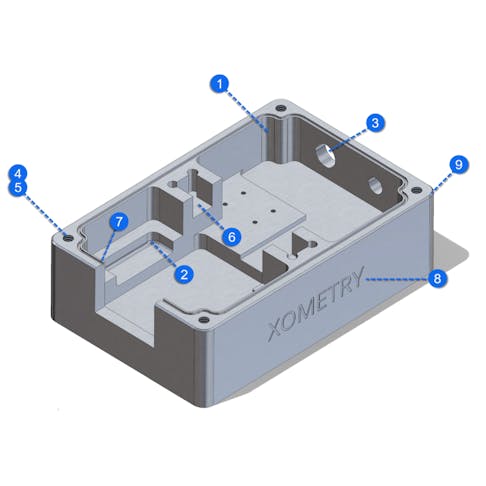Unpack actionable strategies and best practices for CNC machining by listening to this insightful webinar.
Hosted by Xometry’s Greg Paulsen, Director of Applications Engineering, and Steve Zimmerman, Machinist, Toolmaker, and Senior Partner Support Lead, this session explored the elements that play a pivotal role in cost-effective CNC projects, such as material selection, feature complexity, and design guidelines. If you’re a designer or engineer seeking to improve design efficiency and leverage the full potential of CNC machining, this webinar recording was made for you.
Key Takeaways:
- Understand Cost Drivers: Learn the key elements that drive costs in CNC machining and how to implement them in your design process.
- Learn Efficient Design Techniques: Gain insights into Designing for Manufacturability (DFM), including material selection, feature-specific tips, and an understanding of 3-, 4-, and 5-axis features.
- Gain Technical Drawing Mastery: Learn key fundamentals to create concise, effective technical drawings.
Questions and Answers from the LIVE Event
Can you share a copy of the webinar?
Yes, here is a PDF version of the webinar, and we have linked useful resources within! "Trimming Costs, Keeping Quality: Smart Design Tips for CNC Machining."
Where can I find the Xometry CNC design guide?
Check out our CNC capabilities page for quick tips or you can download our CNC design guide PDF.
How do you specify a non-standard thread or feature in my Xometry quote? E.g., M20.8 x 3.
Please upload your model and configure the quote via our Xometry Instant Quoting Engine®. If your thread is not one of our standard threads, you can get a team to review it manually by contacting support@xometry.com or your sales lead. You may also be able to trigger a manual quote review by selecting "Other/Custom" under Finishes and writing in your needs.
I've learned much about Thread Depth, fillet dimensions, and flat-bottomed drilled holes that will help my future part cogs. What's your favorite DFM trick that you think is underutilized or sparks joy whenever you see it?
Just because we can't machine sharp corners doesn't mean there aren't methods to fit sharp features together. I love seeing circular relief cuts in the corners of a square pocket. You can do the same thing for hex sockets and keyed features. They follow DFM best practices and ensure mating parts fit appropriately. Our CNC design reference poster shows that off well.
So when uploading the 3D model to Xometry, do you automatically change to the radius in the bottom or we need to have the radius in there
You will need to design in the radius appropriately for any sharp internal corners.
What types of ID work-hardening are available at Xometry? ie. Ballsizing or roller burnishing?
We can hit any standard machining practice; not all of them may autoquote. If you do not see the option you are looking for, we would request that you choose Other/Custom in your Finish tab and add the requirements for your examples. You also need to upload a technical drawing outlining the requirements for this.
Is a material like 2024 Aluminum low, mid, or higher cost for machining?
You tell me! 2024 aluminum machined parts instantly quote at Xometry, and you can upload your file or take a Test Drive to see how it compares to commodity 6061 aluminum. You'll see that alloy prices are somewhere between 6061 and 7050 alloys.
What are your tips re: ease of machining parts with specific concentricity requirements. In the past I've had issues with stacked tolerances of concentric parts negatively impacting the ability to assemble things after the machined parts arrive. Can I specify an overall concentricity of an assembly instead of individual parts?
This is where GD&T plays a huge role. Well-toleranced GD&T drawings can ensure you have location and fits between components even if they are manufactured at different locations. That, along with limit tolerances (e.g., +.000" / -.010"), can also ensure mating parts will have clearances.
Outside chamfer or fillet? Which feature would be easier to machine?
Chamfers are easier to machine and lower cost, often producible in one machining pass vs several passes or surfacing for external radii.
When should we call out or use chamfers?
Design in chamfers that hold a cosmetic purpose to your part. You do not need to model any edge breaks, Xometry will deburr every machined part you produce. If you prefer a machined edge break, make sure to call that out in a technical drawing.
Does Xometry provide feedback on how many setups and/or the number of mill axes needed for a specific part?
Xometry uses AI and machine learning to build predictive pricing models for our instant quoting. This does not discretely break down machine or operations, but instead answers how a part like this prices on a competitive marketplace.
Does the auto-quote care how solidworks has shown/modeled the thread? For example I think there are three options, hidden, dashed or thread cutout?
Hide the thread! We need a hole modeled to the correct drill size (or with enough material to cut on external threads). An accompanying technical print with the thread call out will be our guide for thread type, depth, and inspection requirements.
Are threaded inserts or tapped blind holes more cost effective?
Taps are cheaper because they do not require extra setups and labor. Typically the use of a threaded insert, such as a helical insert or key set insert, is when you know in the use of the part the thread may wear out or need repair (e.g., the part will feel high shock and vibe). We also see threaded inserts on softer parts, like aluminum or even plastic, adding strength to the assembled components and preventing stripping.
What' the best way to indicate thread depth (versus total hole depth) on a drawing?
At a minimum, the thread form, series, major diameter, threads per inch, class of fit, and depth should be specified. Thread depth is often symbolized with a ↧. E.g., 5/16-18 UNC - 2B ↧ .750" would indicate a thread depth of .75 inches.
If a second order is placed for a part, is there any way to ensure it gets sent to the same supplier as the first order, in order to reduce costs and lead time, because they already have the programming, fixtures, etc?
Yes! We pair repeat work with suppliers to assure quality. Every uploaded part at Xometry gets its own unique Xometry part ID. Upon reorder, the previous manufacturer will get an exclusive offer for this part - a win-win. Pricing may not be affected from the first to the next order.
Can the Solidworks add-in be used to auto update cost without placing order?
You can use any of Xometry's quoting tools to get pricing and lead times; they are free and do not require and order. Of course, when you're ready to move forward, we hope you choose Xometry!
So if I use a 1/4-20 bolt, do I want thread depth to be 0.5?
That would be on the maximum end of our design recommendations: Length < 2x thread diameter. Be sue to add additional hole depth of at least 50% the hole diameter beyond your thread diameter.
Does using imperial vs metric radii, hole sizes, etc. impact pricing?
Holes are holes and we do not have any constraints between units of measurements.
Sometimes my company will design parts with complex curvature (variable radius or multiple axes) that's very difficult to dimension on a drawing and to QA. In that case, is it helpful to the machinist to place a note in the drawing to allow the part to be defined by the CAD file and only provide critical, measurable dimensions? Or is there another preferred approach?
Absolutely. You can add "Limited dimensioned drawing, all non-dimensioned features are CAD-defined." to your drawing notes. At that point, we will follow our Manufacturing Standards for best practices. If you require a dimensional report of a complex curvature, you may need to do the GD&T call out for surface profile. This will require a CMM and extra costs to measure.
Are there standard stock thicknesses?... Say I want a 1/4" thick block with some holes drilled in it but the stock is 1/2" thick would it be cheaper to make the thickness of the block 1/2" so no material needs to be removed and only the holes need to be drilled?
Xometry's CNC machining services assume we are milling all faces of the part. If you have a request to use a standard stock size and keep the top/bottom faces as-is we would need to manually review with our internal team to provide an accurate quote.
When would you use a face mill vs a fly cutter and what are the cost implications?
The finishing passes are dependent on the provided part geometry and strategy used by the Xometry Supplier on your specific project. We typically do not call this out up-front. Sometimes a surface roughness request may dictate the need for a specific pass.
What is a 125 Ra finish?
125 Ra µin (or RMS) is a surface roughness measurement that dictates the average surface's deviation over a prescribed measurement length. 125 is typically the "as machined" look with standard toolpaths; we recommend 32 Ra µin for spots requiring seals or gaskets. Below 32 Ra µin will likely need manual polishing or grinding.
Is the need for special tooling and the cost to buy the unique tool built into the Xometry Instant Quoting Engine®? If so, will I be notified of this and told how to fix it?
Mostly yes, however features that require splines, EDM requirements, porting holes, slitting saws, ACME threads, etc. will need a team review before finalizing the quote. Contact our support team or your sales lead for quick assistance!
Does your instant quoting engine take advantage of 4, 5, and 6 axis machines that can access more sides of the parts to reduce the number of setups?
Our capabilities are based on our broad network of thousands of suppliers and our costing model reflects these capabilities. We certainly have access to multi-axis machining, but the more demanding the design is the higher the price will be due to market factors like count of available shops and specialized overhead. Long story short: Xometry can make practically any machinable design, but designs that inherently add more constraints to how they can be made or sources will drive pricing.
Do you utilize metric tooling as well as US Customary standard tooling? Asking for instances like sizing an internal corner radius slightly larger than standard tooling, like you recommended. Should we aim for sizing larger than the closest metric tool, or closest inch tool? Does it matter?
We'll cut it all! We are agnostic of measurements and deal in both units all the time.
Can you provide a bit more detail on what a curved feature looks like that *can't* be performed on a 3-axis CNC machine. Speaker mentioned that a 3-axis machine can perform curved cuts but sometimes a 4-axis is required. I'd like to hear a bit more about this nuance.
Usually a 4th axis requirement (for CNC) is dictated when there are non-planar holes across a single rotating axis compared a direct-on approach. In other words, if I can do most features from top down, but need to tilt the part in segments that are not 90 degrees, a 4th axis would be helpful. If I need to tilt, and rotate in angular segments, there is a benefit for a 5-axis CNC.
Note that a CNC lathe could be a great option to design around if you have several axial features on your part (e.g., a flanged circular housing). In this case, a CNC lathe is a 4-axis device but makes material removal very quick through turning then hits the details with milling.

